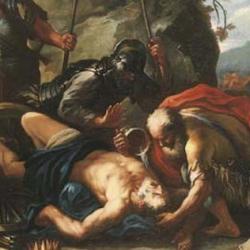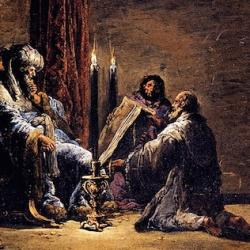The Chronicler’s description of the free-standing cherubim in the temple’s Most Holy Place (2 Chronicles 3:10–13) is delightfully repetitive and complicated. The repetition is more obvious in the Hebrew, so I provide a woodenly literal translation:
A. And he made in the house of the holy of holies two cherubim, sculpted work, and he overlaid them with gold, v. 10
B. Now the wings of the cherubim were twenty cubits, v. 11a
C. The wing of the one was five cubits, touching the wall of the house, v. 11b
D. And the wing of the other was five cubits, touching the wing of the other cherub, v. 11c
C’. And the wing of the other cherub was five cubits, touching the wall of the house, v. 12a
C’. And the wing of the other was five cubits, attached to the wing of the other cherub, v. 12b
B’. The wings of these cherubim spread twenty cubits, v. 13a
A’. And they stood on their feet with their faces toward the house, v. 13b
English translations clarify by distinguishing “the one” or “the first” cherub from “the other,” but in Hebrew “one” (‘echad) is used only in verse 11b, and “other” (‘acher) is used five times. The words are similar in Hebrew, since the daleth and resh differ only by a tittle (a slight overhang).
The picture is clear enough, despite the complicated description. The overall wingspan of the two cherubim together is twenty cubits; each wing is five cubits, so that the span of each cherub is ten; they are set side-by-side in the Most Holy Place, one wing of each touching the wall and the other wing “attached” (daveq) to the other’s wing in the center. Their wings “spread” (parash) twenty cubits, suggesting that they form a canopy or tent (cf. Exodus 40:19). They spread their wings over the ark and its cherubim, who themselves spread their wings over the footstool (Exodus 25:20; 37:9).
“Attach” is from a root meaning “cleave,” and describes the union of husband and wife (Genesis 2:24) and of Israel to her husband Yahweh (Deuteronomy 10:20; 11:22; etc.). The cherubim form a quasi-marital pair in the inner sanctuary. That marital fits the emphasis on the cherubims’ wings (kanaph appears 8x). The form of the cherubim is not specified, nor the material from which they’re made (cf. 1 Kings 6:23-28). They’re all wings and feet.
Wings are associated with marriage. The edges of a man’s robe are “wings” of his garment, and when he stretches his “wing” over a woman he is bringing her into a marital covenant, pitching a tent to house the two who become one flesh.
The wings of the cherubim are the wings of Yahweh under which Israel seeks refuge. They are the wings of Yahweh’s glory that He stretches over His Bride.















